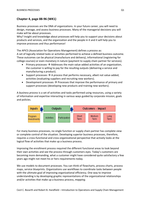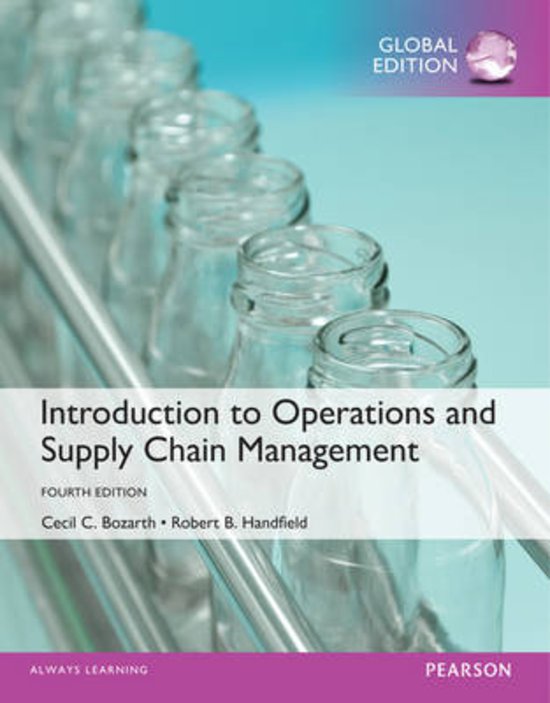BUSINESS PROCESSES Q1
Chapter 4, page 88-96 (WK1)
Business processes are the DNA of organizations. In your future career, you will need to
design, manage, and assess business processes. Many of the managerial decisions you will
make will be about processes.
Why? Insight and knowledge about processes will help you to support your decisions about
products and services, and the organization and the people in it and it will help you to
improve processes and thus performance!
The APICS (Association for Operations Management) defines a process as:
A set of logically related tasks or activities performed to achieve a defined business outcome.
These outcomes can be physical (manufacture and delivery), informational (registering for
college courses) or even monetary in nature (payment to supply chain partner for services).
Primary processes Addresses the main value-added activities of an organization,
the customer is willing to pay for the resulting outputs (delivering a service and
manufacturing a product).
Support processes A process that performs necessary, albeit not value-added,
activities (evaluating suppliers and recruiting new workers).
Development processes Processes that improve the performance of primary and
support processes (developing new products and training new workers).
A business process is a set of activities and tasks performed using resources, using a variety
of information and expertise interacting in various ways guided by corporate mission, goals
and policies.
For many business processes, no single function or supply chain partner has complete view
or complete control of the situation. Developing superior business processes, therefore,
requires a cross-functional and cross-organizational perspective that actively looks at the
logical flow of activities that make up a business process.
Improving the enrollment process required the different functional areas to look beyond
their own activities and see the process through customers eyes. Today’s customers are
becoming more demanding, what a customer might have considered quite satisfactory a few
years ago might not meet his or hers requirements today.
We use models to document processes. You can think of flowcharts, process charts, process
maps, service blueprints. Organizations use workflows to coordinate tasks between people
with the ultimate goal of improving organizational efficiency. One way to improve
understanding is by developing graphic representations of the organizational relationships
and/or activities that make up a business process, mapping.
Cecil C. Bozarth and Robert B. Handfield – Introduction to Operations and Supply Chain Management
, BUSINESS PROCESSES Q1
Creates common understanding of the content of the process: its activities, its
results, and who performs the various steps
It defines the boundaries of the process
It provides a baseline against which the impact of improvement efforts
When we are mapping processes, we are making use of Process Maps. Process Maps are a
very common way of documenting processes. They can be used to analyze a complex
process, by breaking down the process into individual steps or components.
A process map is a detailed map that identifies that specific activities that make up the
informational, physical, and/or monetary flow of a process.
Process Flowchart: A form of process map. This chart simply sets out the sequence of
activities and decision points. A flowchart has stricter rules and often ‘zooms in’ on
processes and sub processes.
1. Identify the entity that will serve as the focal point
2. Identify clear boundaries and starting and end points
3. Keep it simple
Keep in mind that the idea is to document the process as it is, not the way people remember
it. Second, management needs to decide which parts of the process to look at. Areas that are
beyond a manager’s control or are not directly related to the problem at hand can be
omitted from the process mapping effort.
Sometimes we are interested in understanding not only the steps in a process but who is
involved and how these parties interact with each other. Swim lane process maps graphically
arrange the process steps so that the user can see who is responsible for each step.
Cecil C. Bozarth and Robert B. Handfield – Introduction to Operations and Supply Chain Management






